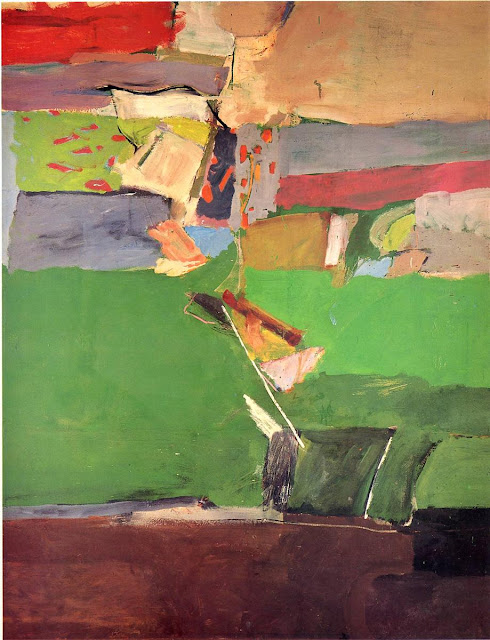Richard Diebenkorn's Berkeley series were executed in a twenty-month period between 1953 and 1955. Apart from being my personal favourites of his work, mainly because they’re colourful semi-abstracted landscapes, these paintings give the viewer an excellent opportunity to examine the work of a major artist in the process of his stylistic development. With this series Diebenkorn achieved his first widespread, formal recognition as an important figure in the Abstract Expressionist movement.
When Diebenkorn returned to Berkeley in 1953, after completing his graduate degree at the University of New Mexico in Albuquerque and teaching for a year at the University of Illinois, he began the Berkeley series, which was to number over forty paintings.
The Berkeley series shows Diebenkorn's absorption of New York Abstract Expressionism which he adapted to his own Western environment and personal idiom. It is important to recognize however, that Diebenkorn belongs to the first generation of Abstract Expressionists along with such Bay Area artists as Hassel Smith and Frank Lobdell. His work in Berkeley represents a fully formed achievement contemporary with that in New York that announced the arrival of the American avant-garde on the world scene.
The early Berkeley pictures, such as Berkeley #8 (1954) are, like the previous works done while still in Albuquerque, cut by horizontal lines or bands of colour suggesting a hilly landscape. Their colours are also reminiscent of the pinks and browns of the earlier New Mexico paintings.
1954 Berkeley #8
1955 Berkeley #23
Diebenkorn's approach to the Abstract Expressionist style differs markedly from that of his New York contemporaries. His line is restrained compared, for example, to the compulsive, energetic line of Franz Kline; Diebenkorn's canvases are composed of flat, brushed, horizontal colour patches, whereas in the works of Jackson Pollock colours were dripped and poured. Diebenkorn's colour sense is distinctly Californian: warm earth colours dominate as opposed to the blacks, grays and whites that generally characterize the New York school.
The Berkeley series pictures were immediately exhibited on both West and East coasts: three were sent to the Third Sao Paulo Biennale in 1955. Following this series Diebenkorn painted a group of still lifes, another of figurative works, and numerous cityscapes. In 1969, after moving to Southern California, he began the Ocean Park series which will feature in the next blog post coming up.
1953 Berkeley #1
1953 Berkeley #5
1954 Berkeley #12
1954 Berkeley #19
1954 Berkeley #22
1955 Berkeley #32
1955 Berkeley #39
1955 Berkeley #46
1955 Berkeley #47
1955 Berkeley #52
1955 Berkeley #54























Poul, I am writing a list for CBS San Francisco's website about best places for impressionist art around SF. Where in SF would I find Diebenkorn's work?
ReplyDeleteWhat's your idea of best places for impressionist art around SF?
CynthiaDWarner@yahoo.com
Cindy
good realisations, vbut they 'll better appear in larger pictures
ReplyDeleteI like these but I wish I could see them in the flesh so see the texture. These are so different from his very linear paintings.
ReplyDeleteliking it
ReplyDelete